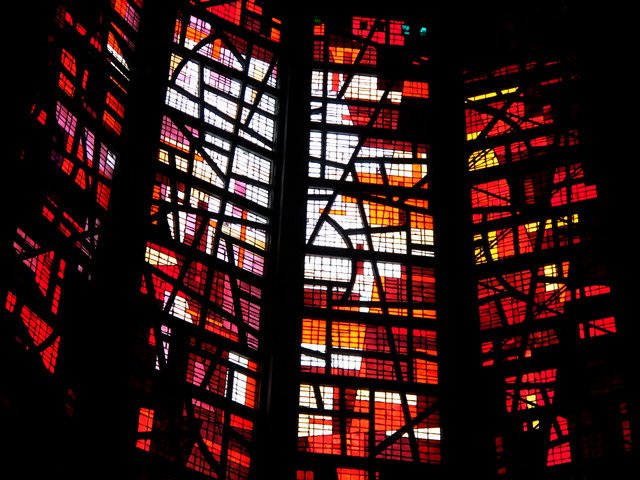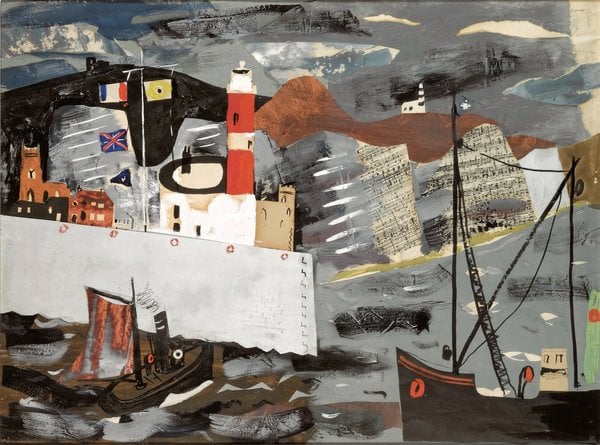
What makes a great British artist? Is it their love for depicting the local landscape and their in-depth knowledge of the coastline? Is it their dedication to the artistic cause, through both peacetime and conflict? Ordinarily, we probably wouldn’t be asking this question at all, yet as Tate Liverpool attempts to justify this uncomplicated exhibition of works by describing John Piper as one of the ‘most significant British artists of the 20th century’, it’s worth thinking through.
Known as a painter, printmaker, writer and stained-glass and stage set designer, Tate’s display attempts to tick all of the roles on Piper’s resume. Rather than building and developing an argument, therefore, the exhibition is more of a broad brush approach to Piper’s life and work. Taken this way, visitors stand to gain some insight into the artist. However, the format of the exhibition adds little to this rather general introduction, leaving us to wonder – could it have been more? Let us turn, then, to look at what can to be learnt from a visit.
Firstly, it seems that John Piper was a hard worker. It has to be said that his artistic journey is a familiar tale – starting off as a law student, he eventually abandoned it to begin art school. For a while he experimented with the contemporary trends of cubism and abstraction and experienced the allure of modernist Paris, before eventually finding his own voice, or at least preference, through sheer creative labour. What becomes apparent here is his dedication to the craft. Piper continued working even through the most undesirable of circumstances during the WWII, honing his skill and training the eye, determined to make his moody visions a reality.
We also learn that he was a great designer who understood the importance of collaboration. If you live in Liverpool, you have probably visited the Metropolitan Cathedral. If you haven’t, then pick a bright day and go to admire the ‘Crown of Glass’ – one of the most stunning stained glass projects in the country, waiting right under your nose. Designed by John Piper and Patrick Reyntiens, it is an extraordinary display of colour on an absolutely huge scale, and its creation and installation necessitated dozens of people.
As part of the show, you will see some of Piper’s sketches and even a little section of the glass itself, but the most fascinating part is the 15-minute documentary which details the long and laborious process of designing, engineering and the eventual creation of the gigantic glass panels with the help of a very large team of experts. This is nowhere near enough and should in fact have been the focus on the show – Piper’s design ability clearly surpassed his painting.

He was also a skilled writer. Although old magazines and documents in glass cases often go unnoticed in art exhibitions, Piper’s writing is worth straining your eyes for. His article on ‘The Nautical Style’ reveals the artist’s deep understanding of design and its functions. As he writes of the marine style and boat design: ‘It is the quality of strong contrasts, more than half functional but partly tasteful, found in the capacity to make a square stone jetty look right in a choppy sea, to put a simple cylindrical tower [a lighthouse] in the right place on a rounded hill, to cut water and air with sharp edges, to exaggerate the lightness of something that floats on the sea and the weight of something that resists it.’ He may have had romantic tendencies, but with that comes a genuine understanding of, and admiration for the significance of design.
Finally, he was, of course, passionate and dedicated to the national landscape. Bearing the title of ‘landscape painter’ often brings up overly romantic connotations and encloses the artist in question in the inescapable realm of tradition. Indeed, John Piper’s work too is quite unashamedly influenced by his land-loving Romantic predecessors. In this case, however, tradition and heritage actually provided a reason for the artist’s work to develop further. Employed as an official war artist, Piper was tasked with recording the crumbling walls of bomb-damaged churches and other national landmarks all around the country. His depictions may not shy away from the Romantic, yet they also display his immense respect for the subject matter and understanding of the emotional effects of colour. Displayed against a deep red wall the paintings look genuinely beautiful, with the depicted ruins still ablaze, against stormy skies. It’s quite lovely, so should we really ask for more?
Simply put, the artist is perhaps more interesting than this exhibition allows us to see. For reasons unknown, the curators clearly insisted on a chronological layout for the show, placing all emphasis and using most of the space for the largely dull early attempts. Many artists start off by copying others from sheer admiration for their heroes, but it shouldn’t be essential viewing when the show focuses on the artist himself and his seemingly individual style. Particularly because displaying Piper’s cubist pieces alongside Picasso’s doesn’t do him any favours.
This could have been rectified in two ways: showing more of the refined landscapes where at the very least the artist shows his confident use of colour with some abstract works woven in for context; or simply accepting that Piper was a better designer than painter and showing a side to the artist that we would not usually expect. The latter would perhaps be the more contemporary and multidisciplinary approach. If only a bold move such as putting design at the centre stage of an established painter’s exhibition would be acceptable in a national gallery, in a £10-per-ticket exhibition. As it stands, we are faced with too many mediocre painting experiments, some pretty later landscapes and an unsatisfying finale of largely unmentioned incredible glass-work. It isn’t awful, but you should probably go to the Cathedral instead.
John Piper is on at Tate Liverpool until 18th March 2018.
Filed under: Art & Photography

Comments